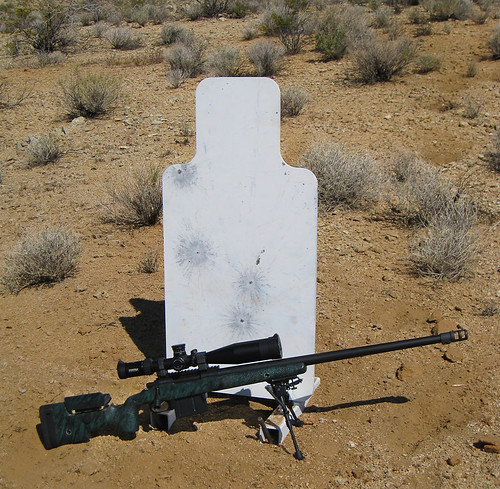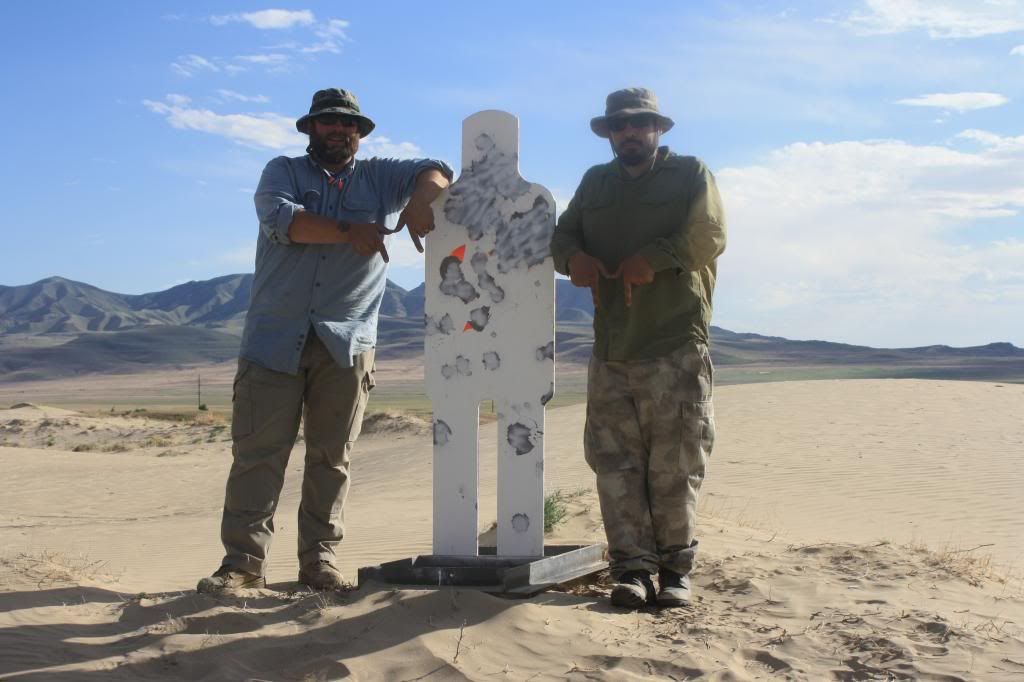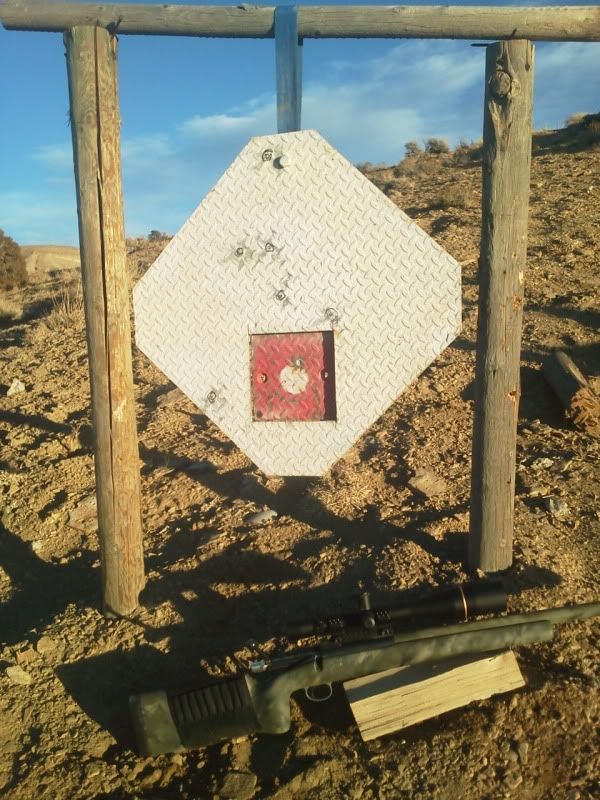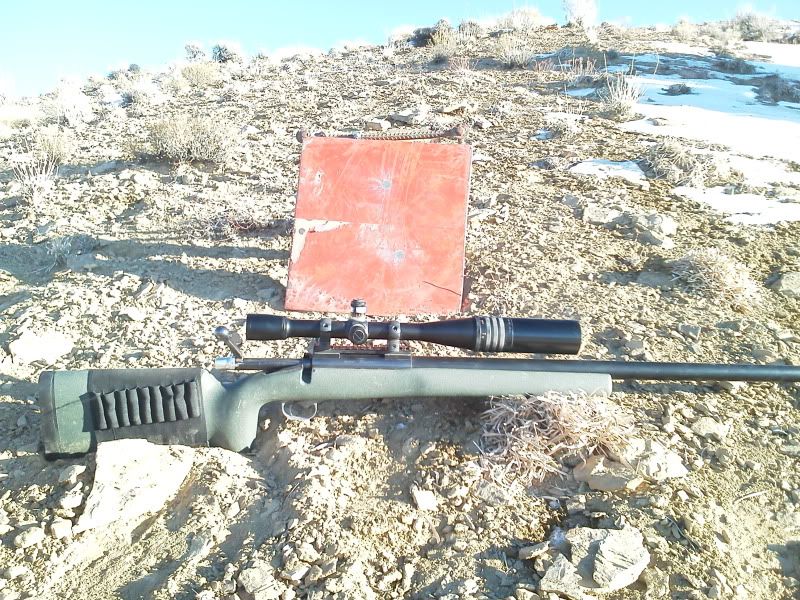338 will be coming soon. Been shooting 1100 yards with creedmoor for couple years. Looking to shoot a mile soon. What target size would you get to start out with? Also what spotting scope would yall suggest. I just bought a terrapin range finder and selling my leica 1600. So for the spotting scope I want to buy once and be able to see whats happening at a mile. Thanks
Join the Hide community
Get access to live stream, lessons, the post exchange, and chat with other snipers.
Register
Download Gravity Ballistics
Get help to accurately calculate and scope your sniper rifle using real shooting data.

Install the app
How to install the app on iOS
Follow along with the video below to see how to install our site as a web app on your home screen.
Note: This feature may not be available in some browsers.
You are using an out of date browser. It may not display this or other websites correctly.
You should upgrade or use an alternative browser.
You should upgrade or use an alternative browser.
Target size for 1 Mile/ spotting scope suggestion
- Thread starter TexasMade
- Start date
TM,
I recently went the path that you did. I will give you my 2 cents worth, but hopefully some folks with more experience chime in. Psyops and I also had gotten comfortable at 1000-1100 yards with the Creedmoors, and recently took the 338s out to a mile.
I don't know how much a spotting scope will help at a mile. When we shot, we had to turn down the S&B scopes from 25x to 20x. Even then, the mirage (and distance) made it hard to spot hits. When the mirage mellowed, we thought we could see a couple hits, and we shot at 6000 feet elevation. I don't know if a good spotting scope will fare any better. On more recent trips, I brought a TargetCam (from TargetCam.net), and we could spot the hits easily (we could see where on the target, the bullet impacted). The targetcam cost a lot less then a high end spotting scope, and every hit was clear.
We had 17.75" wide by 24" tall targets (about 1 MOA wide). They looked like small dots in the scope. We found it challenging but fun. Depending on your comfort level with the 338, it may be worth getting something bigger for the first few times out. I personally like the 17.75"x24" targets since it is doable at a mile, but is still a challenge.
I recently went the path that you did. I will give you my 2 cents worth, but hopefully some folks with more experience chime in. Psyops and I also had gotten comfortable at 1000-1100 yards with the Creedmoors, and recently took the 338s out to a mile.
I don't know how much a spotting scope will help at a mile. When we shot, we had to turn down the S&B scopes from 25x to 20x. Even then, the mirage (and distance) made it hard to spot hits. When the mirage mellowed, we thought we could see a couple hits, and we shot at 6000 feet elevation. I don't know if a good spotting scope will fare any better. On more recent trips, I brought a TargetCam (from TargetCam.net), and we could spot the hits easily (we could see where on the target, the bullet impacted). The targetcam cost a lot less then a high end spotting scope, and every hit was clear.
We had 17.75" wide by 24" tall targets (about 1 MOA wide). They looked like small dots in the scope. We found it challenging but fun. Depending on your comfort level with the 338, it may be worth getting something bigger for the first few times out. I personally like the 17.75"x24" targets since it is doable at a mile, but is still a challenge.
Last edited:
I've normally shot 10x17" and 15"x25" targets to a mile and beyond, the latter obviously being easier to hit at distance. Seeing impacts at those kinds of distances can be difficult unless you've got a fresh high contrast paint on the steel and a good spotting scope. More often than not though, we'd spot the effects of a hit and not see the actual location on the target. A solid hit will wobble the steel and make wide dust impacts on the ground below the target (assuming it's not mounted in soft grass) as the bullet fragments apart. All of this gets quite a bit more difficult beyond a mile as there's less energy to smack the steel. A good quality spotting scope can really make the difference in this regard, but I would say having a few sets of extra eyes observing was the biggest factor.
ETA: incidentally, I started using this flash system last year and it's been SO helpful for ELR shoots, basically making hits something that can easily be determined with the naked eye Kit
ETA: incidentally, I started using this flash system last year and it's been SO helpful for ELR shoots, basically making hits something that can easily be determined with the naked eye Kit
last weekend, i just hit my first 2000 yard target.
(see link in 1000 yards & beyond thread)
my target is 1m high (39") x 1/2 m wide made by LV steel targets.
i sent him my sketch and he plasma cut it in ar500 steel.
i rounded the edges to prevent any sharp objects hitting my foot or head by some sort of pick-up-n'-carry boo-boo and i also had him round the inside corners to prevent any stress joints. besides, the curved corners look kewl. he can cut any shape you send to him.
imo, anything much larger than this just becomes too heavy to manage (mine weighs 80 pounds or so)

at 2000 yards, i't's still quite easy to hone in on at 25x
i made the target 1m tall to make it compatible with the FFP mil system in my scope and at 1000 yards, it is exactly 1 mil-hash mark tall.
anyway, at this distance, your image can become obliterated by mirage, even with the best $3000 spotting scope glass. and also, at this distance, i really do not need to know how far off from center i am because my bullet grouping (dispersion) at this distance is greater than that target size anyways - hence, i do not need to measure the target center to bullet strike distance because the bullet strike coordinates have much greater dispersion than if i were shooting say, a target at 600 yards where the group size is only a few inches. i mainly look for a dust cloud to see where i am hitting (if off due to windage or whatever) and measure the correction using the FFP scope. - that is to say, i say that a hit is a hit. if it is dead center, i consider that a chance of the draw over skill. you'd have to measure 20 rounds of strikes and do an average to determine where it is truly aimed at and then make the correction off an average grouping over just a single shot.
(see link in 1000 yards & beyond thread)
my target is 1m high (39") x 1/2 m wide made by LV steel targets.
i sent him my sketch and he plasma cut it in ar500 steel.
i rounded the edges to prevent any sharp objects hitting my foot or head by some sort of pick-up-n'-carry boo-boo and i also had him round the inside corners to prevent any stress joints. besides, the curved corners look kewl. he can cut any shape you send to him.
imo, anything much larger than this just becomes too heavy to manage (mine weighs 80 pounds or so)

at 2000 yards, i't's still quite easy to hone in on at 25x
i made the target 1m tall to make it compatible with the FFP mil system in my scope and at 1000 yards, it is exactly 1 mil-hash mark tall.
anyway, at this distance, your image can become obliterated by mirage, even with the best $3000 spotting scope glass. and also, at this distance, i really do not need to know how far off from center i am because my bullet grouping (dispersion) at this distance is greater than that target size anyways - hence, i do not need to measure the target center to bullet strike distance because the bullet strike coordinates have much greater dispersion than if i were shooting say, a target at 600 yards where the group size is only a few inches. i mainly look for a dust cloud to see where i am hitting (if off due to windage or whatever) and measure the correction using the FFP scope. - that is to say, i say that a hit is a hit. if it is dead center, i consider that a chance of the draw over skill. you'd have to measure 20 rounds of strikes and do an average to determine where it is truly aimed at and then make the correction off an average grouping over just a single shot.
Last edited:
Thanks guys I appreciate it. Im thinkin bout looking at the target cam now! I like your target size lost coyote. Out here in lubbock we are literally voted the worst weather in the nation. Wind averages 20mph a day. Id like that size I think to build some confidence. You can always go smaller
Last month was at a three day class where we're engaging targets at 2000 yards. We were shooting across canyons with mirage not an issue that day and we're shooting an IPSC sized target. I was spotting using a Spotter 60 dialled up to 60x and could see impacts on and around targets and for the most part could discern where the rounds impacted the target. When shooting at 25x the target was barely visible in the scope but was able to see splashes on the target.
338 will be coming soon. Been shooting 1100 yards with creedmoor for couple years. Looking to shoot a mile soon. What target size would you get to start out with? Also what spotting scope would yall suggest. I just bought a terrapin range finder and selling my leica 1600. So for the spotting scope I want to buy once and be able to see whats happening at a mile. Thanks
TM
As others, we started with spotting scopes, then went to camera system for a mile and up. Target sizes are usually 15"x24" for a mile and 2'x3' further out.
My friend Mark Dalzell created his own system without breaking the bank; other systems such as Targetcam and Bullseyes are GTG too. For longer distances, an extra antenna is often needed, check with the manufacturer.
We use his system every time we shoot ELR, monitor screen is crystal clear.
Check out this link: https://vimeo.com/53482636
Last edited:
That's a nice target cam system he made..... Gonna need to do something like this soon....
As far as target size suggestions go, a year or two ago I would have told you to never go bigger than a moa and if you can hit it just work your way back. Now however, I would recommend something that's even up to 2moa to start.
The reason for my change in opinion is that it makes things more 'fun'. You get to ring the steel more often, which keeps you enticed and coming back for more practice. It can be disheartening to keep shooting and not hit anything. Feels like a waste of bullets. The other reason for the larger target is so that you can actually see your hits and correct. You can always try to center the shots and work on that.
Once you gain some experience, get yourself a 1moa target and just leave the larger one for 2k+!
As far as target size suggestions go, a year or two ago I would have told you to never go bigger than a moa and if you can hit it just work your way back. Now however, I would recommend something that's even up to 2moa to start.
The reason for my change in opinion is that it makes things more 'fun'. You get to ring the steel more often, which keeps you enticed and coming back for more practice. It can be disheartening to keep shooting and not hit anything. Feels like a waste of bullets. The other reason for the larger target is so that you can actually see your hits and correct. You can always try to center the shots and work on that.
Once you gain some experience, get yourself a 1moa target and just leave the larger one for 2k+!
Last edited:
I hear you; Mark is good with that electronic stuff. I was always the guy with a .308, 50 rounds of ammo and a bottle of water...then years later, I picked up ELR.
Now I need "stuff" that I didn't even know existed
Now I need "stuff" that I didn't even know existed
For out to a mile I use a 22" gong and I can see hits on it with my Razor HD spotter 20-60x85. Only problem I had was finding the dang target once we got back to our shooting position. Next time I get to shoot out that far I think I am going to take one of my dune flags I use on my ATV to mark the target.
for 1000 yards and out, I like to use either 20 inch rounds or 24x24 squares. Both in 1/4" AR500. It rings super loud and it awesome!
Stephen and Lars flashing "M"s for mile hits. Paint the steel white before shooting, and place the targets near cleared sandy areas so you can see your bullets kick up dust splashes.

A standard 5'10" E-type is a challenging mile target -- at 1780 yards it's just a little wider than a minute, and almost 4 MOA high. If you have a MOA- to minute-and-a-half capable hardware combination with good Standard Deviation and minimal Extreme Spread it comes down to your ability to point the rifle consistently and your ever-critical wind calls.
An exceptional spotting scope helps if you're shooting multiple targets (multiple camera/transmitter systems would be expensive) and electronic hearing protection will let you hear bullets hitting steel (albeit with a delay).

A standard 5'10" E-type is a challenging mile target -- at 1780 yards it's just a little wider than a minute, and almost 4 MOA high. If you have a MOA- to minute-and-a-half capable hardware combination with good Standard Deviation and minimal Extreme Spread it comes down to your ability to point the rifle consistently and your ever-critical wind calls.
An exceptional spotting scope helps if you're shooting multiple targets (multiple camera/transmitter systems would be expensive) and electronic hearing protection will let you hear bullets hitting steel (albeit with a delay).
30" across the short flats....I use it for 1 mile +....my WSM swings it around on a 2100 yard hit so its fairly easy to spot for myself. If your shooting steel tap a balloon to the steel before you start shooting....any hit on the plate will splatter the bullet and pop the balloon.

The first time I hit 1 mile I was shooting at a 14x14" plate.

I don't generally use spotting scopes so no help there.

The first time I hit 1 mile I was shooting at a 14x14" plate.

I don't generally use spotting scopes so no help there.
Last edited:
I have a variety of targets that I have used @ 1,800 yards and beyond (so far out to 2,300 yards). Mostly I now use an 18"x24" AR500 silhouette, painted optic green. I have no problem seeing it with my rifle scope dialed down to 20-25X. (the mirage can be brutal in the desert near Vegas).
Spotters - I have used a bunch of different spotters, including a 40+X Zeiss w/ ED glass. Ultimately I have settled on a set of 100mm objective binoculars with a fixed 25X (not remotely tactical, but you can see amazingly well with them). With these I can generally see individual hits on steel at 2300 yards (unless the mirage is brutal).
Jeffvn
Spotters - I have used a bunch of different spotters, including a 40+X Zeiss w/ ED glass. Ultimately I have settled on a set of 100mm objective binoculars with a fixed 25X (not remotely tactical, but you can see amazingly well with them). With these I can generally see individual hits on steel at 2300 yards (unless the mirage is brutal).
Jeffvn
We had a 1-meter tall 1/2-meter wide piece of 3/16" T1 steel hanging at 1500-meters (1640-yards). The steel is so thin that a 30-cal 175-gr bullet will make it shimmy a little. It's far enough out that even a 338/416 Rigby only puts shallow dents in it. I can see my hits shooting my 308 with 3-15 Premier. It helps putting a band of aluminum tape (like they use in HVAC duct work) across the top so you can see the reflection of the sun flash when the target moves under high mirage conditions. Unfortunately, the tape doesn't last long.
We now have that target at 2060-yards, and I've only hit it once with my 300WM.
We now have that target at 2060-yards, and I've only hit it once with my 300WM.
Last edited:
If I could find a place to shoot anywhere around here I use a 18" X 30" sil. Where are you shooting to a mile around Lubbock? I sent you a PM.
Took my wife to Thunder Valley Precision over the weekend. It was her first time shooting past 100 yards. She made hits on 12"x12" steel at 1k and a mile(I've since been busy with lots of reloading) .
Conditions were excellent and calling out corrections were made easy with Zen Ray spotting scope. Cameraland sells them at a good discount.
Conditions were excellent and calling out corrections were made easy with Zen Ray spotting scope. Cameraland sells them at a good discount.
Sinisters steel(and lostcoyotes) is tough to beat.
What I can contribute is that having some elevation difference between you and the target will make spotting quite a bit easier.
Mirage has eaten me alive in terms of spotting and tracking hits.
Placing your steel in an area that has no vegetation and ideally dusty soil will really help.
The photo sinister posted shows your best case scenario for spotting hits.
On that trip I was using a 12-42 Nightforce BR and had it set at R(22x+/-).
With a 10 degree down angle I could see hits and misses clearly with my optic and due to TOF could spot my own.
I was shooting a fag mag so YMMV as far as recoil recovery.
What I can contribute is that having some elevation difference between you and the target will make spotting quite a bit easier.
Mirage has eaten me alive in terms of spotting and tracking hits.
Placing your steel in an area that has no vegetation and ideally dusty soil will really help.
The photo sinister posted shows your best case scenario for spotting hits.
On that trip I was using a 12-42 Nightforce BR and had it set at R(22x+/-).
With a 10 degree down angle I could see hits and misses clearly with my optic and due to TOF could spot my own.
I was shooting a fag mag so YMMV as far as recoil recovery.
Similar threads
- Replies
- 16
- Views
- 1K
- Replies
- 5
- Views
- 464
- Replies
- 20
- Views
- 816
- Replies
- 10
- Views
- 717
